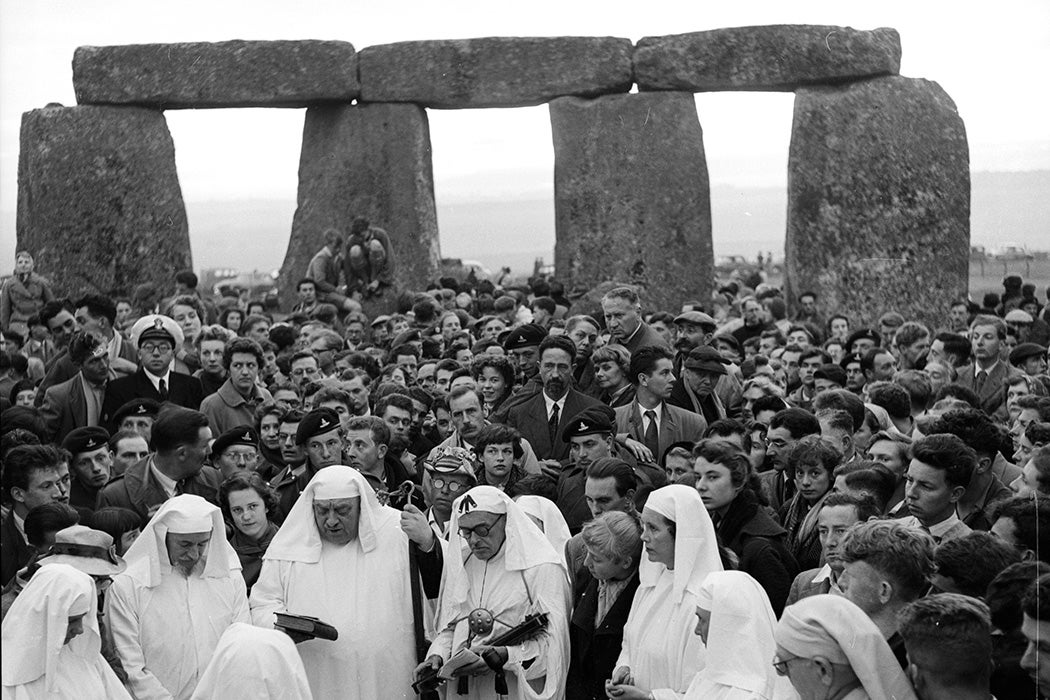Seventeenth-century English antiquarians thought that Stonehenge was built by Celtic Druids. They were relying on the earliest written history they had: Julius Caesar’s narrative of his two unsuccessful invasions of Britain in 54 and 55 BC. Caesar had said the local priests were called Druids. John Aubrey (1626–1697) and William Stukeley (1687–1765) cemented the Stonehenge/Druid connection, while self-styled bard Edward Williams (1747–1826), who changed his name to Iolo Morganwg, invented “authentic” Druidic rituals.
Druidism has come a long way since. In 2010, The Druid Network was listed as a charity in England and Wales, essentially marking the official recognition of Druidism as a religion. (74,000 called themselves Druids in a recent census.) Historian Carole M. Cusack positions Druidism as one of the branches of the tree of Paganism and/or New Age-ism(s), which burst into all sorts of growth during the twentieth century. Modern Druidism fits into the smorgasbord of what Cusack calls the “deregulated spiritual marketplace” of our times.
But there’s a disconnect here. In the popular imagination, Stonehenge and Druidism now go together like tea and crumpets. Historically, Stonehenge, a product of Neolithic Britain, predates Caesar by thousands of years. It had nothing to do with Druids and certainly nothing to do with modern Druidism.
“The false association of [Stonehenge] with the Druids has persisted to the present day,” Cusak writes, “and has become a form of folklore or folk-memory that has enabled modern Druids to obtain access and a degree of respect in their interactions with Stonehenge and other megalithic sites.”
Meanwhile, archaeologists continue to explore the centuries of construction at Stonehenge and related sites like Durrington Walls and the Avenue that connects Stonehenge to the River Avon. Neolithic Britons seem to have come together to transform Stonehenge into the ring of giant stones—some from 180 miles away—we know today. Questions about construction and chronology continue, but current archeological thinking is dominated by findings and analyses of the Stonehenge Riverside Project of 2004–2009. The Stonehenge Riverside Project’s surveys and excavations made up the first major archeological explorations of Stonehenge and surroundings since the 1980s. The project archaeologists postulate that Stonehenge was a long-term cemetery for cremated remains, with Durrington Walls serving as the residencies and feasting center for its builders.
The hippie-turned-New Age movements birthed in the 1960s and 1970s resulted in a surge of interest in Stonehenge. Tens of thousands, not all of them Druids, attended the Stonehenge Free People’s Festival starting in 1974. In 1985, the festival was halted by English Heritage, the organization that maintains Stonehenge today, because of the crowds, disorder, and vandalism. Druids were also banned from performing rituals on site. However, English Heritage and the Druids soon came to an understanding: Druids could use the site as long as there was no associated festival.
So the clash of academic archaeology and what might be called folk archaeology comes into stark focus at Stonehenge.
Weekly Newsletter
Modern paganism is not without interest, of course, but continuing revelations about prehistory—whether of neolithic Britain or elsewhere—should be a lot more interesting. As are the techniques used to extract data from the past: an example used to telling effect by the Stonehenge Riverside Project is the analysis of lipid remains on pottery: we can tell if the pot held dairy products or the fat of ruminants or pigs, giving insights into the diet four thousand years ago. Another example: strontium isotope in bovine molars show that beef consumed at Durrington Walls was raised at least thirty miles away.
Of course, all this is not as photogenically mysterious/magical as robed Druids in the long shadows of a midwinter sunset. Academic archaeology, which suffers from charges of “elitism” in the reactionary populist politics of anti-intellectualism and anti-science, has a hard time competing with the popular irrationality of mysticism. Maybe the real Stonehenge needs more publicists.
Support JSTOR Daily! Join our membership program on Patreon today.







